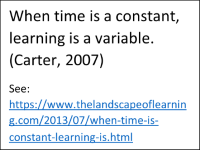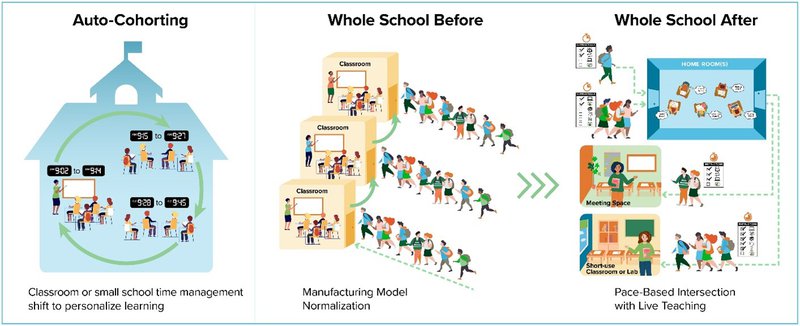
The future is probably not the manufacturing-line whole-group tradition or the fully online model. It’s somewhere in between in a complex matrix that uses both online digital learning and paper resources learning strategically intersected with on-demand live teacher-led experiences in a by-subject perfection of personalization that doesn’t sacrifice social interactions. Also known as Hybrid Logistics or Hybrid Hyflex only modified to add School A.I. calendaring.

“On-demand live teacher-led experiences” and a “complex matrix” is a mind-bender to consider if you are still thinking with whole-group learning, classes and old-fashioned master schedules. You might even still be thinking of courses rather than paths.
Erase all that thinking and replace it with A.I. calendaring that automates large groups being invited to a “class” which is not yet set on the calendar but “floats” and will set once it has its first full cohort out of that larger group. Let’s say it’s five students in one cohort. Once the fifth student completes the work they were supposed to already do that is written in the instructions section of the meeting request and they hit “accept,” the A.I. will now search the teacher’s open time and drop in the class to all five students and the teacher. The A.I. will already be accruing the next five students. If by some chance a sixth completes their work and accepts the meeting, they can be added to the other five if that meeting hasn’t happened in real time yet. That’s so number six doesn’t have to wait for the next meeting to set when more accept.
There’s more to the story of how this A.I. works to manage time and space differently, but the key here is that it allows all learning to be pace-based while not sacrificing the intersection with live teaching moments which could be long labs, lectures, group discussions, or short check-ins. The design is highly flexible so that every subject can find it’s norm of class meetings versus the individual studying of resources. When not land-locked in classrooms, which could be used now only as meeting spaces and teachers’ offices, a lot of the discipline and running-of-the-whole-group recedes to be replaced by teachers spending time customizing and roaming to aid those in need. Students could mostly be in study halls or homerooms or “Flex spaces.” On some campuses, that would be converted extra large classrooms overseen by a rotation of teachers or para-professionals. Digital calendars could appear in those homerooms with a look akin to airport flight boards showing who needs to go where and when.
One of the goals here is to leverage teachers while providing time equity to all students on every subject.
Now that you have the concept of one class which has disaggregated into smaller cohorts each pacing independently, you should see in your minds eye how over time how this allows faster students to zoom ahead. They’d be in meeting five when others were only on meeting two, and so forth, eventually spreading through time similar to the facts of our differences as human learners.
Now add the complexity of a student joining your school a few months into the year. All the meetings are still “open,” and they can join at the beginning and the A.I. will still trigger a “class of one” with that teacher. Or you can test that student and put them in at any point of the continuum of that subject’s learning and they join their nearest fellow traveler students for upcoming meets or wait for a few behind to catch up to them. Subjects are then pathways, something beyond “courses” only because they are always-open and there is no definitive start or end, which for higher ed could be revolutionary. No enrollment dates is a game-changer.
Ancillary to this pace-based model of teaching moments and resources which could be digital or paper-based, you’d also have to have a master schedule with unique features. You’d come across potential issues such that a few students who were way ahead in, say, math, but behind in language learning might need their overall schedule adjusted to take from one and give to another. A.I. can do that easily. The time-on-task still meets total minutes requirements as calculated by the A.I. on independent study and live teacher-led lesson parts.
You would also find that you’d need all these teacher meetings, classes if you will, to have open time that is still bracketed. Those are called “holds.” Holds can cover multiple hours of the day but subtract out breaks such as would be normal in a school for transit time and lunches, etc. In this way a normal hour that would have otherwise been for 6th grade math with a separate hour for 5th grade math teaching by one teacher can actually be thought of as one block of two hours for any 5th or 6th grade meeting to land.
Also envision that a schedule is given to every individual for what to study when as well as a pattern for teacher time “on duty” to take meetings or roam.
All students would still be within their social age groups. All students would be known to have a custom schedule of what to study when and most would have a nearly identical schedule in any age group. All students could be given an incentive will be to try to “save minutes” by getting through materials perfectly, intersecting with teachers for those needed moments, but in the end hopefully having more use a larger amount of flex time on individual or group projects and electives such as robotics, art, esports, other special online excursions, etc., for extra credit or workforce readiness.
Our research shows it is this level of customization with time and task that is of high interest to the public because they can find it commercially. Students well behind in subjects would have their schedules take up not just the regular minutes in core but also most of flex time, but since everyone’s schedule is not 100% aligned and the patterns look random, there is no social stigma. Johnny has an extra math meeting during flex time, Amy has an extra literacy meeting with a teacher, and this may be their prerogative, and not an indication of being behind. They could be concentrating towards a future in STEM or literature while others are hoping to get a career later in building esports games, etc. This will be a cultural thing by school leaders to create – everyone has their own path/emphasis. Identifying teachers as masters of many-grade subjects will help with this. Breaking grade-groups-by-age would eventually have slightly mixed age groups without necessarily having an older student identify that they are behind but that a few younger ones are concentrated in that subject or that the older ones had earlier concentrated in another subject.
It is only an assumption that we need to teach all core subjects every year rather than having a couple years that are only math, or only literacy, and so forth. Again, breaking our thinking of the old model to make learning the constant and not time could take many directions in the future.
Until some legislative changes are made in most States, prep for high-stakes tests for grade groups would still have to happen and would be planned into the master schedule. School leaders would have to find out if one student who is in disparate grade levels by subject is tested with their age group in every subject, or how their local laws require them to do it. If it is okay to do tests-by-subject with the appropriate age/grade group to the individual, that would be the best fit with pace-based learning.
The reasons are plenty that A.I. calendaring for schools, brought about by a movement towards figuring out better hybrid learning logistics during the pandemic, is an inevitable future for all schools.
The U.S. has a non-homogenous population encompassing hundreds of languages and cultures now, an epic teacher shortage, lots of absenteeism, general economic fears, a dramatic shift out of offices to distance work in most industries, and a different experiential expectation of schools since the pandemic, are all contributing to a need for a change to learning structure. This is different than learning programs calling out things like STEM or literacy, its playing with how time and space are used. We have not “played with structure” since we thought up distance and online learning, neither of which are a good fit for all.
Going in the direction of learning that provides the right fit for each and every student is more of a structure of time and space flexibility than it is the techniques of teaching only. Fifty percent of students learned better during the pandemic when mostly online but still having some video conferencing time with teachers. The other fifty percent learned very little and reputedly need the social energy of co-learners around them to ignite their own learning. That’s just the human condition, and there are probably many shades of gray in there for every individual based on subject and their daily condition of health and emotional outlook.
What’s true for most people today is that we do need human connection, and human teaching. We just need it leveraged to perfection. When it is whole group only, we leave some students behind and others bored. When we have teachers attempt to always small-group and fix every individual need with direct instruction we overburden the teacher. Out system is built to normalize for a society that no longer exists.
Present society expects great digital experiences and the edtech field has built truly great learning online, but there is still human teaching needed. How do we use both and break the old norms?
School A.I. Calendaring.
Only Knowstory.com has offered a commercial school A.I. calendar and a lot of its features are still in development. Piloting schools are seeing great success. While every piece gets operational, any school going in the direction of Hybrid Logistics as part of their strategy to leverage fewer teachers, provide better personalization and more, they still have to get their whole tactical plan in place with curriculum.
It’s time to start that journey of what grades, subjects, and curriculum will be included in first steps towards a true transformation of teaching and learning.
Learning Counsel News Media would like to thank Cisco for their continued support sponsoring the Hybrid Logistics Project.











